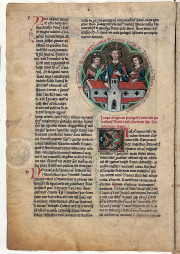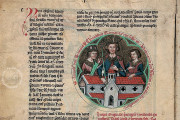The Book of Zwettl, also known as "bear's skin" due to its binding, is one of the chief sources for Austrian history and art of the early fourteenth century. The book is incredibly useful for understanding both the history of the monastery where it was produced, but also the happenings in Austrian economy and land ownership.
The Book of Zwettl: the History of a Dynasty
The manuscript is mainly focused on the history of the Kuenring dynasty, founder of Zwettl monastery. Its deeds are described by means of an incredible wealth of source material, that must have been painstakingly collected by the book's composer. The Book of Zwettl is undoubtedly a deluxe manuscript, but it was nevertheless used on a daily basis, something extremely unusual for a manuscript bearing this number of illuminations. Furthermore, the book must have certainly been a 'representative codex,' as is apparent from its various feather drawings and excellent illuminations, coupled with large full-page miniatures displaying the dynasty's family tree adorned with golden medallions.
Text and Illuminations
The Book of Zwettl's feather drawings and matte-color illustrations were probably the work of an unknown painter who must have worked in the area surrounding Vienna. Initials and character depictions were obviously created at the same time as the text, which, though written in Latin, also contains snippets in Middle German and was penned by different hands. The text itself has various decorated letters colored in red, but also rubrics for chapter titles, probably the work of Cistercian monks, something that would have helped the reader immediately find the passage he needed. The book's binding, on the other hand, which soon gave it its name 'bear's skin,' was indeed made from the skin of a male pig, more commonly known in Austria as the 'sow bear'.
The History of a Cistercian Abbey through Its Sources
Even though its script and illuminations match those of a deluxe book, the Book of Zwettl is a somewhat late example of historical narrative combined with documentary sources as is more commonly found around 1200. Documents and deeds produced by the monastery in which it was produced had begun to be collected as early as 1315, thus resulting in this extremely opulent manuscript containing both first-hand accounts of the history of Zwettl Abbey, but also an extensive description of the deeds of its founding family. The first to begin a systematic gathering of primary sources in his abbey was abbot Ebro, a monumental task that was continued by his successors Otto I and Gregory, the latter being the one who eventually drafted the text altogether.
We have 1 facsimile edition of the manuscript "Book of Zwettl "Bear Skin"": Das Stifterbuch des Klosters Zwettl ("Bärenhaut") facsimile edition, published by Akademische Druck- u. Verlagsanstalt (ADEVA), 1981
Request Info / Price


